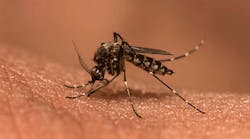For years, researchers have been trying to crack the mystery of why mosquitoes torment some people while leaving others alone. It is unfair when you are working outdoors, or are simply trying to relax in your backyard and you (and only you) are the mosquito snack.
Meanwhile, your coworkers, friends and family remain blissfully bite-free. What gives? Better figure it out now in preparation for all those buggy Fourth of July BBQ’s to come.
Here are a few mosquito facts courtesy of the American Mosquito Control Association that might help explain why mosquitoes ignore some people and persecute others, and why some mosquito bites seem larger or more itchy than others:
- Some form of mosquitoes existed as far back as the Triassic Period – 400 million years ago.
- There are about 2,700 species of mosquito. There are 176 species in the United States.
- The average mosquito weighs about 2.5 milligrams.
- The average mosquito takes in about 5-millionths of a liter of blood during feeding.
- Mosquitoes find hosts by sight (they observe movement); by detecting infra-red radiation emitted by warm bodies; and by chemical signals (mosquitoes are attracted to carbon dioxide and lactic acid, among other chemicals) at distances of 25 to 35 meters.
- Mosquitoes fly an estimated 1 to 1.5 miles per hour.
- Salt marsh mosquitoes can migrate up to 40 miles for a meal.
- Larger people often are more attractive to mosquitoes because they are larger targets and they produce more mosquito attractants, namely CO2 and lactic acid.
- Active or fidgety people also produce more CO2 and lactic acid.
- Smelly feet are attractive to certain species of mosquitoes – as is Limburger Cheese.
- Dark clothing has been shown to attract some species of mosquitoes more than lighter colored clothing.
- Movement increased mosquito biting up to 50 percent in some research tests.
- A full moon increased mosquito activity 500 percent in one study.
Mosquitoes are not just a nuisance. They can spread potentially fatal diseases. Diseases that can be transmitted by mosquitoes include:
- Eastern equine encephalitis
- Japanese encephalitis
- La Crosse encephalitis
- St. Louis encephalitis
- West Nile virus
- Western equine encephalitis
- Dengue Fever
- Malaria
- Rift Valley Fever
- Yellow Fever
There are things you can do to limit mosquito activity and improve your chances of remaining bite-free:
Water: Eliminate standing water, which acts as a breeding ground for mosquitoes. The sources of standing water can include flowerpots, children’s pools, watering cans, gutters etc.
Trash: Remember to keep the lids on trashcans to keep out the rain.
Puddles: Cover up or fill in low places in your yard where puddles can develop.
Gutters: Keep gutters cleaned out so water does not build up inside and become a mosquito breeding ground.
Drains: Make sure all drains on your property also are cleaned out without leaves blocking them up so water can drain effectively.
Pipes: Repair leaky pipes and outdoor faucets.
Toys: Empty plastic wading pools at least once a week or store in a position that allows the water to drain.
Pools: Make sure your backyard pool is maintained properly.
Bird baths and planters: Change water in bird baths and planter pots or drip trays at least once a week.
Grass: Keep grass cut short around the house, so adult mosquitoes will not hide there.

